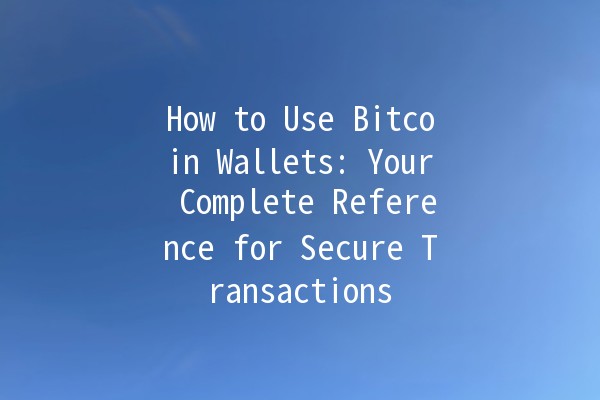
to Bitcoin Wallets
Bitcoin wallets serve as digital vaults where your cryptocurrencies are stored. Unlike traditional wallets that hold physical cash, a Bitcoin wallet is primarily a software application that allows you to store, send, and receive bitcoins securely. Understanding how to use Bitcoin wallets is crucial to engaging in the cryptocurrency ecosystem effectively.
Using a Bitcoin wallet not only facilitates transactions but also adds a layer of security to your assets. In this article, we'll explore the various types of Bitcoin wallets, how to set them up, and practical tips for maximizing security and productivity when managing your digital currency.
Types of Bitcoin Wallets
Software wallets are programs or applications that can be installed on your computer or mobile devices. They are userfriendly but can be vulnerable to malware if your device is hacked. Here are two common types:
Desktop Wallets: Installed on your computer, these wallets provide you with complete control over your private keys. Example: Electrum.

Mobile Wallets: These wallets run on your mobile devices and are convenient for onthego transactions. Example: Mycelium.
Hardware wallets are physical devices, like USB drives, designed to store your Bitcoin securely offline. They are less susceptible to hacking and provide enhanced security. Example: Ledger Nano S.
A paper wallet is a physical document that contains your Bitcoin public and private keys. It is considered very secure as it is stored offline. However, it can be easily lost or damaged.
Web wallets are cloudbased services that store your Bitcoin online. They are accessible from any device with internet access but are more vulnerable to attacks. Example: Coinbase.
Setting Up a Bitcoin Wallet
Step 1: Choose the Right Type
Decide which type of wallet best suits your needs based on factors such as convenience, security, and accessibility.
Step 2: Download or Purchase Your Wallet
For software wallets, download the wallet application from the official website or app store.
For hardware wallets, purchase from a reputable manufacturer to avoid counterfeit products.
Step 3: Installation and Backup
For software wallets, install the application and follow the setup instructions.
Create a backup of your wallet by writing down the recovery phrase provided during the setup process.
Step 4: Fund Your Wallet
Once your wallet is set up, you can fund it by purchasing bitcoins from a cryptocurrency exchange or transferring from another wallet.
Step 5: Transactions
Now you can start sending and receiving bitcoins securely through your wallet!
Tips for Enhancing Your Bitcoin Wallet Experience
Tip 1: Enable TwoFactor Authentication (2FA)
Enabling twofactor authentication adds an extra layer of security. This means, in addition to your password, you'll need to provide a second piece of information (like a code sent to your phone) to access your wallet.
Example: Most mobile wallets, like blockchain.com, offer 2FA. Be sure to enable it during your account setup.
Tip 2: Keep Your Wallet Software Updated
Regular updates to your wallet software can protect you from vulnerabilities. Ensure autoupdates are enabled or check for updates regularly.
Example: Ledger wallets provide updates through their Ledger Live application, which you should check periodically.
Tip 3: Use Strong Passwords
A strong password is crucial in protecting your wallet. Use a combination of upper and lowercase letters, numbers, and symbols.
Example: You can use a password manager to generate and store complex passwords securely.
Tip 4: Regularly Backup Your Wallet
Make periodic backups of your wallet, especially after making significant transactions or changes. Store these backups in multiple secure locations.
Tip 5: Verify Addresses Before Transactions
Before sending bitcoins, always verify the recipient's wallet address. A simple typo can result in losing your funds permanently.
Example: When copying addresses, use the QR code feature if available to minimize errors.
Frequently Asked Questions
A Bitcoin wallet is a digital tool that allows users to store, send, and receive bitcoins. It stores the public and private keys required to manage one's bitcoins securely.
Security depends on the type of wallet you use and your security practices. Hardware and paper wallets are generally more secure than software and web wallets. Following best practices is vital to ensure maximum security.
When choosing a Bitcoin wallet, consider factors like security, ease of use, and your particular needs (e.g., daily transactions vs. longterm storage). Research different wallets and read user reviews to help in your decision.
Yes, if you lose access to your wallet or your keys, you may lose your bitcoins permanently. It's essential to keep your recovery phrases and backup files secure.
If you suspect your wallet has been hacked, immediately transfer any remaining funds to a new secure wallet. Change your passwords and enable 2FA on your accounts.
Yes, a Bitcoin wallet is necessary to store and manage your bitcoins securely. Without a wallet, you won't have a way to access or deal with your cryptocurrencies.
Choosing and using a Bitcoin wallet effectively can enhance your experience in the cryptocurrency market. By implementing the above tips and techniques, you can enjoy secure transactions and peace of mind while managing your digital assets. With the right practices in place, you can navigate the world of Bitcoin wallets confidently and securely.
By understanding how to utilize your wallet efficiently and securely, you can minimize risks and maximize your productivity in handling your Bitcoin transactions. Celebrate your ventures into the world of cryptocurrencies and take control of your financial future!

